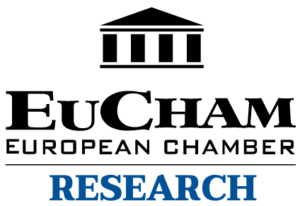EuCham – European Chamber lists the richest European countries for human capitals based on HDI (Human Development Index). The HDI was created by UN to emphasize that people and their capabilities should be the ultimate criteria for assessing the development of a country, not economic growth alone. HDI is a summary measure of achievements in key dimensions of human development: life expectancy, education and income indices.
|
EuCham Research Human Development Index in Europe
United Nations Development Program data 2014 |

Source: eucham.eu/charts |
Detailed Information
EuCham – European Chamber lists the richest European countries for human capitals based on HDI (Human Development Index). The HDI was created by UN to emphasize that people and their capabilities should be the ultimate criteria for assessing the development of a country, not economic growth alone. HDI is a summary measure of achievements in key dimensions of human development: life expectancy, education and income indices.
Europe performs well with 20 countries in the global top 30 HDI list. Norway is also the world leader, achieving a HDI value of 0.944. The countries following at the top are Switzerland, Netherlands, Germany and Denmark. At the bottom of the rankings there are countries from the Balkans such as Macedonia, Bosnia and Herzegovina, Albania and Moldova.
Further analysis shows that the top 5 countries achieved a steady growth over 20 years from 1980 to 2000 (Figure 1), but in the last 13 years the growth has slightly declined particularly due to the increase perceived risk of terrorism and the economic recession of 2007. On the other hand, countries like Moldova and Serbia achieved a sharp increase in development, nevertheless still far behind compared to other European countries.
However, EuCham would suggest to consider also sustainability and environmental factors for further development of HDI.
Methodology
The HDI is the geometric mean of normalized indices for each of the three dimensions. Minimum and maximum values (goalposts) are set in order to transform the indicators expressed in different units into indices between 0-1. These goalposts act as the ‘natural zeroes’ and ‘aspirational goals’, respectively, from which component indicators are standardized.
Figure 1 has been created based on the values in the database of the United Nations Development Program. Average annual HDI growth percentage values have been used throughout the years from 1980 to 2013, having three different groups, annual growth between 1980-1990, 1990-2000 and 2000-2013.
Table 1: Human Development Index in Europe
|
HDI rank |
Country |
HDI value |
|
1 |
Norway |
0.944 |
|
2 |
Switzerland |
0.917 |
|
3 |
Netherlands |
0.915 |
|
4 |
Germany |
0.911 |
|
5 |
Denmark |
0.900 |
|
6 |
Ireland |
0.899 |
|
7 |
Sweden |
0.898 |
|
8 |
Iceland |
0.895 |
|
9 |
United Kingdom |
0.892 |
|
10 |
Liechtenstein |
0.889 |
|
11 |
France |
0.884 |
|
12 |
Luxembourg |
0.881 |
|
13 |
Belgium |
0.881 |
|
14 |
Austria |
0.881 |
|
15 |
Finland |
0.879 |
|
16 |
Slovenia |
0.874 |
|
17 |
Italy |
0.872 |
|
18 |
Spain |
0.869 |
|
19 |
Czech Republic |
0.861 |
|
20 |
Greece |
0.853 |
|
21 |
Cyprus |
0.845 |
|
22 |
Estonia |
0.840 |
|
24 |
Lithuania |
0.834 |
|
23 |
Poland |
0.834 |
|
26 |
Andorra |
0.830 |
|
25 |
Slovakia |
0.830 |
|
27 |
Malta |
0.829 |
|
28 |
Portugal |
0.822 |
|
29 |
Hungary |
0.818 |
|
30 |
Croatia |
0.812 |
|
31 |
Latvia |
0.810 |
|
32 |
Montenegro |
0.789 |
|
33 |
Belarus |
0.786 |
|
34 |
Romania |
0.785 |
|
35 |
Russia |
0.778 |
|
36 |
Bulgaria |
0.777 |
|
37 |
Turkey |
0.759 |
|
39 |
Serbia |
0.745 |
|
41 |
Ukraine |
0.734 |
|
42 |
Macedonia |
0.732 |
|
43 |
Bosnia and Herzegovina |
0.731 |
|
45 |
Albania |
0.716 |
|
46 |
Moldova |
0.663 |
Sources: United Nations Development Program, Human Development Report (2014),
EuCham Research Department – Compiled by Agnes Kovatsova and Kim Dung Tran 2015-01-06